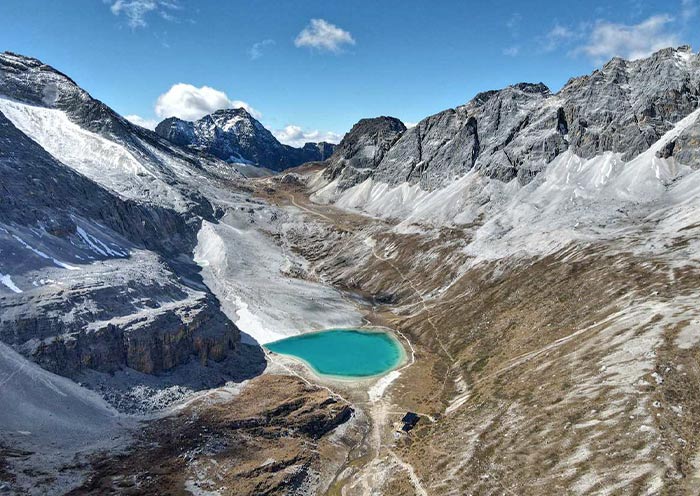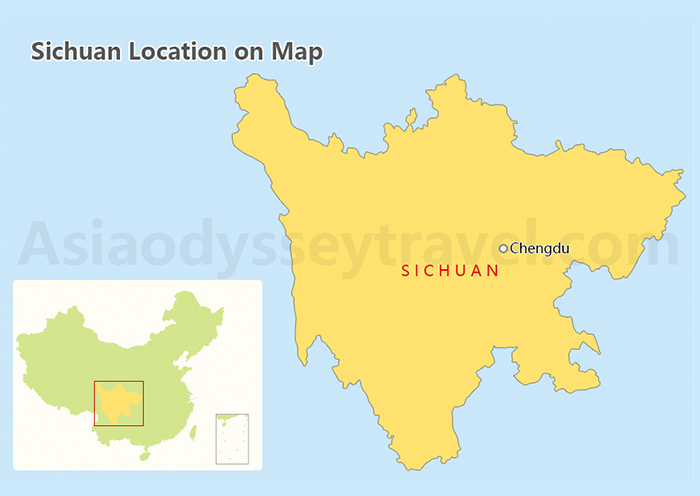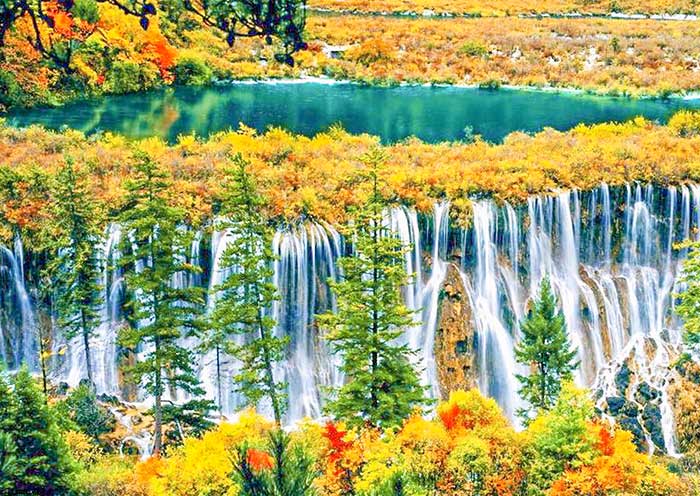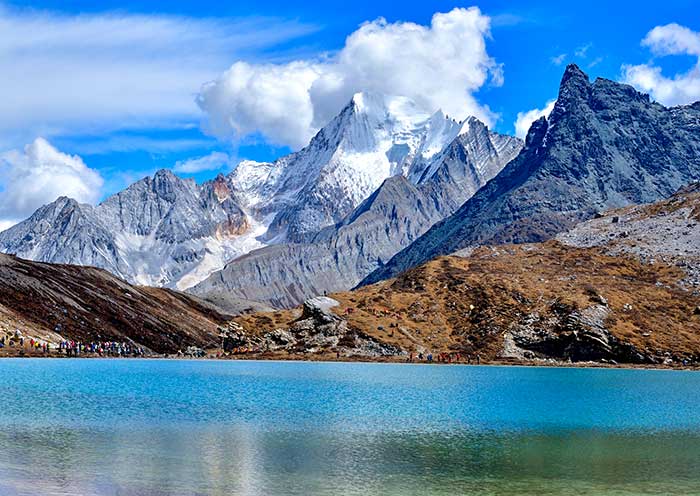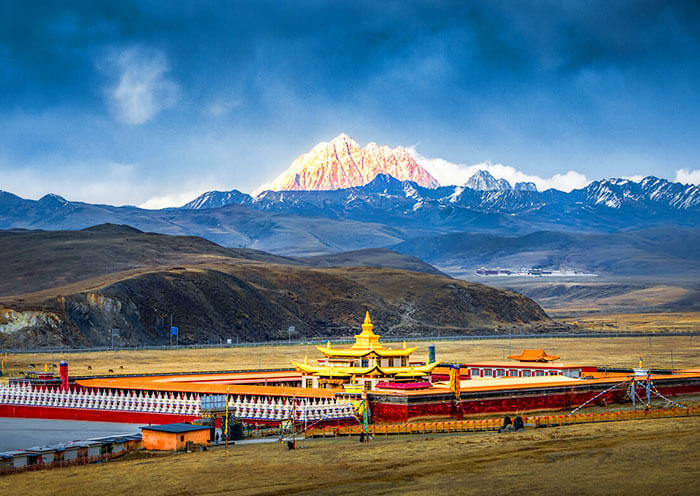Sichuan Tibet Highway G318 Overview with Map


The Sichuan Tibet Highway, also known as G318, is a major highway in China that connects Chengdu, the capital of Sichuan Province, with Lhasa, the capital of Tibet Autonomous Region. Here is an overview of the Sichuan Tibet Highway (G318):
- Length: 2,142 kilometers (1,331 miles). It is one of the longest and most scenic highways in China.
- Route: Starts in Chengdu, Sichuan and passes through several cities and towns, including Ya'an, Kangding, Litang, Batang, and Markam, before reaching Lhasa in Tibet.
- Road Condition: Some sections are well-paved and maintained, while others may be more rugged and require cautious driving.
- Altitude: The G318 is characterized by large altitude fluctuations, so the scenery along the way has become the biggest attraction of the G318. The average altitude of the entire route is about 3,000 meters. Some sections exceed 4,000 meters.
The Sichuan Tibet Highway, G318, offers a remarkable journey through diverse landscapes, providing an opportunity to experience the beauty of Sichuan and Tibet. However, it's important to plan and prepare accordingly, considering factors such as altitude, road conditions, and travel permits, to ensure a safe and enjoyable trip.
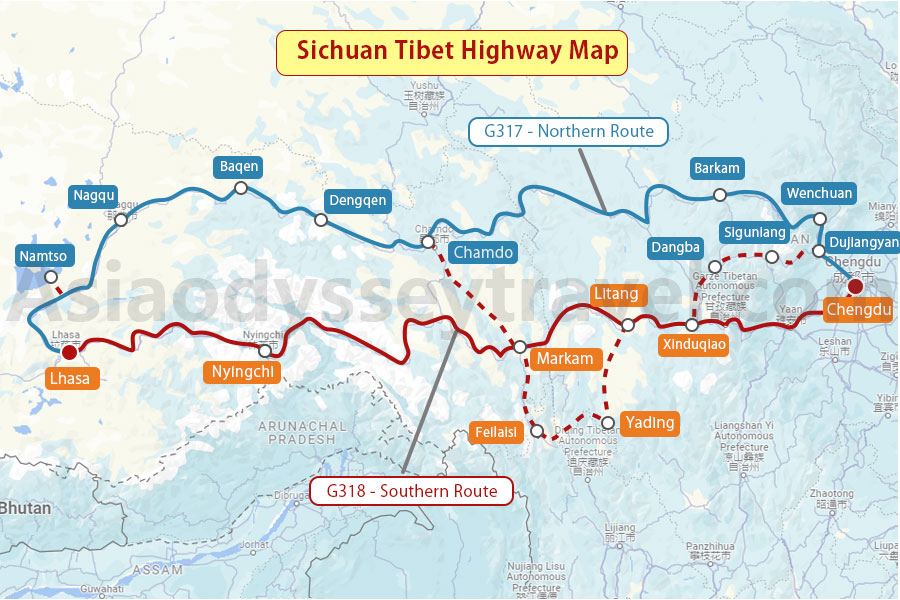
Why Choose Sichuan Tibet Highway G318 to Visit Tibet
1. Scenic Beauty
The Sichuan Tibet Highway offers breathtaking and diverse landscapes throughout the journey. Traveling along this highway allows you to experience stunning natural beauty, including snow-capped mountains, deep valleys, grasslands, rivers, and alpine scenery. The route passes through some of the most picturesque regions in China, providing a memorable and visually captivating journey.
2. Cultural Exploration
The Sichuan Tibet Highway passes through areas with significant cultural and historical importance. Along the route, you can encounter Tibetan Buddhist monasteries, and traditional Tibetan villages, and experience the unique Tibetan culture and way of life. It offers an opportunity to immerse yourself in the rich cultural heritage of Tibet and interact with local communities.
3. Accessibility and Connectivity
The Sichuan Tibet Highway provides a relatively convenient and accessible route to reach Tibet from mainland China. Starting from Chengdu, a major transportation hub, the highway offers connectivity to various regions in Sichuan Province before entering Tibet. This makes it a popular choice for travelers who want to combine a visit to Tibet with other destinations in Sichuan.
4. Adventure and Off-the-Beaten-Path Experience
The Sichuan Tibet Highway is known for its adventurous nature and off-the-beaten-path experience. It takes you through remote and less-visited areas, providing a sense of adventure and exploration. The rugged terrain, high mountain passes, and challenging road conditions make it an exhilarating journey for those seeking an adventurous travel experience.
5. Flexibility and Customization
Traveling by road along the Sichuan Tibet Highway allows for flexibility and customization in your itinerary. You can choose to make stops at various towns and attractions along the route, allowing you to explore at your own pace and discover hidden gems. It provides the freedom to tailor your journey according to your preferences and interests.
6. Acclimatization to Altitude
The Sichuan Tibet Highway offers a gradual ascent to higher altitudes, which can help with acclimatization to the altitude of Tibet. This is particularly important as Tibet is situated at a significantly higher altitude, and ascending gradually can reduce the risk of altitude sickness.
Overall, the Sichuan Tibet Highway (G318) offers a captivating and adventurous journey to Tibet, combining natural beauty, cultural exploration, and the thrill of an off-the-beaten-path experience.
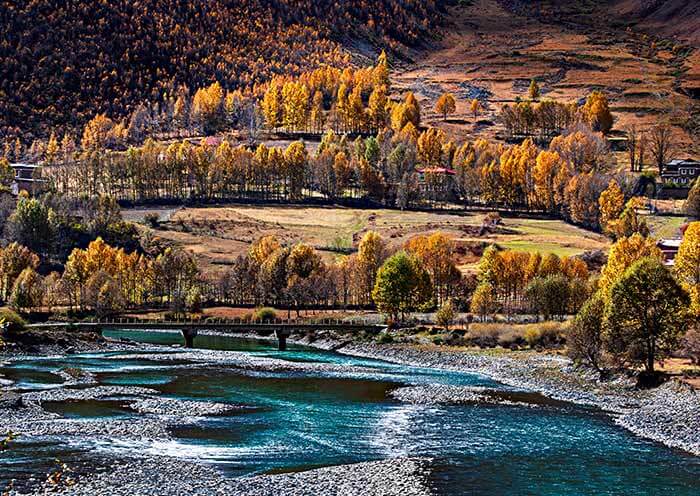

What to See along Sichuan Tibet Trip via G318
Zheduo Mountain (折多山) - Sichuan - 4298 meters
Zheduo Mountain and Pass are located in the western part of Kangding County of Sichuan Province, China. Zheduo Mountain is a majestic peak that reaches an elevation of approximately 4,298 meters (13,450 feet). It is a prominent landmark along the G318 highway and marks the first high-altitude pass where the elevation exceeds 4,000 meters.
The Zheduo Mountain Pass is a crucial transportation route that cuts through the mountainous terrain, connecting the Sichuan Basin with the Tibetan Plateau. The pass offers stunning views of snow-capped peaks, deep valleys, and dense forests, creating a picturesque and breathtaking section of the highway.
Xinduqiao (新都桥) - Sichuan - 3300 meters
Xinduqiao, also known as the "Photographer's Paradise," is a scenic town located in the western part of Sichuan Province, China. The town is famous for its expansive grasslands, snow-capped mountains, and meandering rivers, creating a breathtaking backdrop for capturing stunning photographs. The combination of rolling hills, colorful wildflowers, and clear blue skies makes Xinduqiao a true visual delight.
Besides its natural beauty, Xinduqiao also offers a glimpse into Tibetan culture and traditions. Traditional Tibetan houses with prayer flags fluttering in the wind dot the town, adding to its charm. Visitors can explore local Tibetan villages, interact with friendly locals, and experience the warm hospitality of the Tibetan people.
Litang (理塘) - Sichuan - 4010 meters
Lithang County, nestled in the Garzê Tibetan Autonomous Prefecture of Sichuan Province, China, is a captivating destination perched on the majestic Tibetan Plateau. With its lofty altitude reaching approximately 4,014 meters above sea level, it boasts awe-inspiring landscapes of snow-capped peaks, expansive grasslands, and pristine lakes.
The county is home to Letong Ancient Town, a charming and well-preserved town that showcases traditional Tibetan architecture, winding streets, and a vibrant local atmosphere. Additionally, Lithang County is graced by the presence of Changqingchun Ke'er Monastery, a significant Tibetan Buddhist monastery that exudes spiritual serenity and offers a fascinating glimpse into Tibetan religious practices.
Daocheng Yading Nature Reserve (稻城亚丁) - Sichuan - 2900-4700 meters
Daocheng Yading Nature Reserve, located in the Garzê Tibetan Autonomous Prefecture of Sichuan Province, China, is a pristine and breathtakingly beautiful natural area. It is often referred to as the "Last Shangri-La" due to its stunning alpine scenery and untouched landscapes. The nature reserve encompasses three sacred snow-capped peaks: Chenresig, Jampelyang, and Chanadorje, which are considered holy by Tibetan Buddhists. These towering mountains, along with crystal-clear lakes, lush meadows, and dense forests, create a picturesque setting that attracts nature lovers, hikers, and photographers from around the world. Visitors can embark on scenic treks, witness the vibrant colors of the changing seasons, and explore the charming Tibetan villages that dot the region.
Check more details in Daocheng Yading Nature Reserve >>


The Great Bend of Jinsha River (金沙江大拐弯) - Yunnan - 2500 meters
The Great Bend of Jinsha River is a remarkable bend in the course of the Jinsha River, which is the upper reach of the Yangtze River in Yunnan Province, China. At the Great Bend, the river makes a sharp turn from its southward flow and changes direction to the northeast, forming a sweeping U-shape. This bend is known for its scenic beauty, with the river winding through deep gorges and majestic mountains. It is a popular tourist destination, offering breathtaking views, boat tours, and opportunities to explore the surrounding natural landscapes.
Feilai Temple & Meili Snow Mountain (飞来寺&梅里雪山) - Yunnan - 3439 meters
Meili Snow Mountain, also known as Kawagarbo, is a majestic mountain range located in the Yunnan province of southwestern China, near the border with Tibet. It is part of the larger Hengduan Mountain Range and is renowned for its stunning beauty and sacred significance.
Located at the foot of Meili Snow Mountain, Feilai Temple is a significant Tibetan Buddhist monastery and offers panoramic views of the majestic Meili Snow Mountain range. The snow-capped peaks and serene surroundings make it a popular attraction for nature enthusiasts and spiritual seekers.
Yanjing Ancient Salt Field (盐井古盐田) - Xizang (Tibet) - 2300 meters
The Yanjing Ancient Salt Field is located in Yanjing Town, Markam County of Chamdo, Tibet, on the east and west banks of the Lancang River. With a history of over 1,300 years, Yanjing Ancient Salt Field is an interesting historical site where salt was traditionally produced.
The salt pans and terraced fields of the Yanjing Ancient Salt Field create a visually captivating landscape. The intricate network of salt ponds, divided by narrow paths and embankments, showcases the traditional techniques employed in salt production. The saltwater from the Lancang River is channeled into the field, allowing for the natural evaporation process that yields salt crystals.


Zizhu Temple (孜珠寺) - Xizang (Tibet)- 4800 meters
Zizhu Temple, also known as Zizhu Monastery, is perched atop Zizhu Mountain in Dingqing County, Chamdo, Tibet. It sits at a staggering elevation of about 4,800 meters (15,748 feet), making it one of the highest temples in Tibet. Zizhu Temple holds significance for adherents of the Bon religion, a pre-Buddhist spiritual tradition that originated in Tibet. It is considered one of the oldest and most important monasteries for the Yongzhong Bon religion. The founding of Zizhu Temple is shrouded in mystery, with estimates placing its establishment as far back as 2,000 to 3,000 years ago.
Chamdo Gamagou (昌都噶玛沟) - Xizang - 3700 meters
Chamdo Gamagou, situated in Gama County, Karuo District, Chamdo City, is located approximately 100 kilometers north of the city center. This region has a rich historical background, resulting in a significant concentration of artisans and descendants of craftsmen from Nepal, India, Sikkim, Lhasa, and mainland China. As a result, Gamagou has earned a reputation as the "Land of Artisans" and the "Land of Thangkas."
The skilled craftsmen in Gamagou excel in the art of painting lifelike Buddhist thangka images and creating exquisite Buddhist bronze statues. Their craftsmanship showcases an exceptional level of detail and precision, capturing the essence of Buddhist traditions. This artistic expertise has made Gamagou a renowned destination for those seeking authentic and intricately crafted thangkas and bronze statues.
Namtso Lake (纳木错) - Xizang - 4718 meters
Namtso Lake is one of the three holy lakes in Tibet and holds great spiritual significance for Tibetan Buddhists.
The name Namtso translates to "Heavenly Lake," and it truly lives up to its name. The lake stretches across a vast area, with its crystal-clear turquoise waters reflecting the surrounding snow-capped mountains and endless sky. The serene environment of Namtso makes it a popular destination for those seeking peace, solitude, and a deep connection with nature.
Check more details in Namtso Lake >>

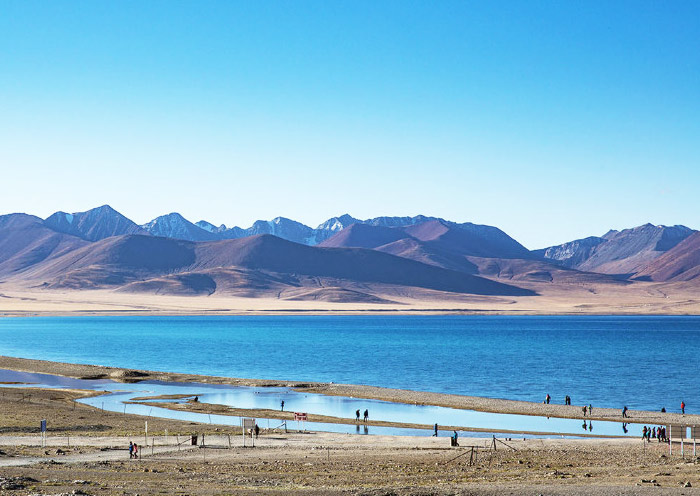
These are just a few of the many attractions and scenic spots along the Sichuan Tibet Highway (G318). Each of these destinations showcases the natural beauty, cultural heritage, and spiritual essence of the region, making the journey along G318 a memorable and enriching experience.
Best Time to Travel from Chengdu to Lhasa by Road
The best time to travel from Chengdu to Lhasa by road is in the spring months of April and May, as well as the autumn months of September and October. During these times, you can enjoy colorful blooming flowers in summer and vibrant autumn foliage, which enhance the scenic beauty along the route.
It's worth noting that summer is the rainy season, and heavy rainfall may result in landslides and mudslides along the way, posing risks to travel. Additionally, winter brings icy and snowy conditions that can lead to road closures or difficult passage.
Therefore, to avoid potential weather-related challenges and fully appreciate the picturesque landscapes, it is recommended to plan your road trip from Chengdu to Lhasa during the spring or autumn months.
How Many Days to Travel through Sichuan Tibet Highway G318
Traveling along the Sichuan Tibet Highway G318 typically takes around 8 days without major detours. However, most itineraries include visits to notable attractions along the route, such as Daocheng Yading and Chamdo.
From Lithang, you can head to Daocheng Yading. After exploring this scenic area, you have the option to either continue on G318 or take a diversion towards the Yunnan-Tibet Highway G214. This alternative route leads you through the Great Bend of Jinsha River and the awe-inspiring Meili Snow Mountain before reaching Markam, where it merges with G318.
From Markam, you can choose to continue westward on G318, passing through Basu and Bomi. Alternatively, you can head north from Markam to the captivating city of Chamdo in eastern Tibet. Chamdo offers its own unique attractions and cultural experiences.
Here is a suggested itinerary for Chengdu to Lhasa G318 road journey
Day 1 Chengdu Arrival, Free Exploration in the Hometown of Giant Pandas.
Day 2 Chengdu - Kangding - Zheduo Mountain Pass - Xinduqiao - Yajiang
Day 3 Yajiang - Litang - Haizi Mountain Scenic Area - Daocheng White Pagoda
Day 4 Daocheng - Yading Nature Reserve - Yading Village
Day 5 Yading Village - Yading Nature Reserve - Xiangcheng Village
Day 6 Xiangcheng County - Zhongde Village - Jinsha Bend - Deqin - Feilai Temple (Yunnan)
Day 7 Feilai Temple (Yunnan) - Yanjing Scenic Area - Markam County (Tibet)
Day 8 Markam County - Chagyab County - Chamdo Gamagou
Day 9 Chamdo Gamagou - Dingqing (Dengqen) County
Day 10 Dingqing (Dengqen) County - Zizhu Temple - Baqing (Baqen) County
Day 11 Baqing (Baqen) County - Nagqu - Damxung
Day 12 Damxung - Namtso Lake - Lhasa
Day 13 Lhasa Departure


Extend Your Tour in Tibet after Arrival in Lhasa
This 5-day tour focuses on exploring the highlights of Lhasa, including the Potala Palace and Jokhang Temple, before heading to the picturesque Yamdrok Lake to experience its stunning beauty and serene ambiance.
This 8-day journey combines the must-see attractions of Lhasa with a thrilling adventure to Everest Base Camp. Along the way, visit Yamdrok Lake, Karola Glacier, and Tashilhunpo Monastery in Shigatse, before reaching the base camp of the world's highest peak.
This 9-day tour allows you to explore three important cities in Tibet: Lhasa, Nyingchi, and Shigatse. Discover the cultural and historical treasures of Lhasa, enjoy the breathtaking landscapes of Nyingchi, and visit significant monasteries and landmarks in Shigatse.
Building upon the previous 9-day itinerary, this 11-day tour adds a visit to Everest Base Camp, providing an opportunity to witness the awe-inspiring grandeur of Mount Everest. Experience the cultural richness of Lhasa, the natural beauty of Nyingchi, and the majesty of Everest.
This 13-day journey combines the Lhasa and Everest Base Camp tour with additional highlights in Ali. Explore Lake Manasarovar, the ruins of Guge Kingdom, and the sacred Mount Kailash. Conclude the tour with a road journey to Kathmandu, Nepal, via the Gyirong border.
What Documents Do I Need to Travel to Tibet from Sichuan by Road
When traveling to Tibet from Sichuan by road, you will need the following documents:
- Tibet Travel Permit: This permit is a requirement for all foreign visitors traveling to Tibet. It can only be obtained through a registered tour operator in Tibet. Once you have your Chinese Entry Visa, your tour operator (Asia Odyssey Travel) will help you arrange your itinerary and apply for the Tibet Travel Permit on your behalf.
- Alien's Travel Permit (ATP): The ATP is necessary for visiting certain restricted areas in Tibet, such as Mount Everest Base Camp or specific border regions. Asia Odyssey Travel will assist in obtaining the ATP by submitting the necessary documents, including your Tibet Travel Permit.
- Military Permit: If you plan to visit sensitive areas in Tibet, such as Mount Kailash or Lake Manasarovar, you will need a Military Permit. It is important to note that the Military Permit is required specifically for these restricted areas and is separate from the Tibet Travel Permit and Alien's Travel Permit.
It is important to arrange your trip to Tibet through a registered tour operator (Asia Odyssey Travel) as independent travel in Tibet is not permitted for foreign visitors. We will handle the necessary permits and provide you with a guide for the entire journey along the highway and into Tibet.


Dining and Accommodation During the Road Journey via G318
When embarking on a road journey along the G318, it's important to be aware of the dining and accommodation options available:
Accommodation:
For foreign tourists traveling to Tibet, it is mandatory to be accompanied by a guide. In major cities and tourist areas along the Sichuan-Tibet Highway (G318) route, such as Yajiang, Litang, Daocheng Yading, Batang, Chamdo, Bomi, and Linzhi, there are qualified international hotels available with relatively good facilities. However, it's important to keep in mind that due to the higher altitude and remote locations along the route, the accommodation environment may be slightly inferior compared to hotels in larger cities like Chengdu, and the costs may be higher.
Dining:
Along the Sichuan-Tibet tour route, the main dining options are Tibetan cuisine and Sichuan cuisine. Tibetan cuisine features specialties such as yak meat, momo (dumplings), thukpa (noodle soup), and tsampa (roasted barley flour). Sichuan cuisine offers spicy and flavorful choices. Hotels and guesthouses along the route may also offer some Western dishes on their menus. However, if you have specific dietary preferences or are not particularly fond of Tibetan or Sichuan cuisine, it's advisable to bring your own food throughout the journey. This ensures that you have suitable options, especially in remote areas where dining choices may be limited.
What to Pack for the Sichuan Tibet Road Journey
When packing for a road journey along the Sichuan Tibet Highway (G318), it's important to consider the unique characteristics of the region and the specific needs of your trip. Here are some essential items to pack:
- Clothing: Dressing in layers is key to adapting to the changing weather and temperature fluctuations along the route. Include warm clothing such as a down jacket, fleece or wool sweaters, thermal base layers, and waterproof outerwear. Don't forget to pack comfortable and sturdy walking shoes or hiking boots for any trekking or exploration you plan to do.
- Altitude sickness remedies: As you'll be traveling through high-altitude areas, it's advisable to pack altitude sickness remedies such as medication (if prescribed by a healthcare professional), Diamox (acetazolamide), or natural remedies like ginger candies or herbal teas. It's always a good idea to consult with a healthcare professional before taking any medication.
- Snacks and water: Pack some non-perishable snacks like energy bars, nuts, and dried fruits, as well as a refillable water bottle to stay hydrated throughout the journey.
- Electronic devices and chargers: Bring your camera or smartphone to capture the stunning landscapes along the way. Don't forget to pack chargers, extra batteries, and power banks to ensure your devices stay powered up during the trip.
- Personal hygiene and toiletries: Pack your preferred toiletries, including a towel, sunscreen, lip balm, hand sanitizer, wet wipes, and any other personal hygiene items you may require.
Remember to pack light and prioritize essential items. It's also recommended to check the weather forecast and consult with your tour operator (Asia Odyssey Travel) or local experts for any specific packing recommendations based on the season and region you'll be traveling through.


Explore Sichuan Tibet Highway with AOT
Embark on a captivating adventure along the Sichuan Tibet Highway with AOT (Asia Odyssey Travel). Are you ready to explore the stunning landscapes and cultural treasures that await you? The Sichuan Tibet Highway is a legendary route that winds through the picturesque mountains and valleys, offering breathtaking views and encounters with the rich Tibetan culture.
With our extensive knowledge and expertise in the Sichuan Tibet Highway, Asia Odyssey Travel offers a variety of carefully crafted tour packages to suit every traveler's preferences.
Highlights along the Route: Kangding, Tagong Grassland, Litang, Danba, and Daocheng Yading
Tour Packages: Sichuan Tibet Highway Tours, Chengdu to Lhasa Overland Tours, Cultural Exploration of Tibetan Regions
Tailored Experiences: We understand that each traveler has unique interests, so we provide personalized tours that cater to your preferences. Our experienced guides will accompany you, sharing fascinating insights and stories along the way, ensuring a seamless and enriching travel experience.
Logistics Made Easy: From transportation arrangements to accommodations, we take care of all the logistics, ensuring a smooth and comfortable journey along the Sichuan Tibet Highway.
24/7 Assistance: Our dedicated team is available round-the-clock to provide support and address any inquiries or concerns you may have during your trip.
Prepare to be captivated by the awe-inspiring landscapes and immerse yourself in the vibrant Tibetan culture along the Sichuan Tibet Highway. Let AOT be your trusted companion as we unveil the wonders of this iconic route, creating memories that will last a lifetime. Join us on this extraordinary journey and let the magic of the Sichuan Tibet Highway unfold before your eyes.
